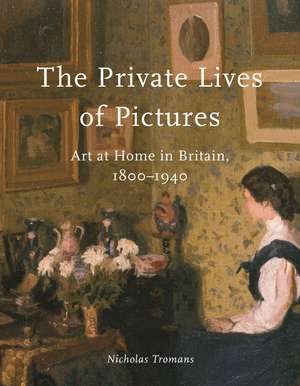The Private Lives of Pictures: Art at Home in Britain, 1800–1940
Autor Nicholas Tromansen Limba Engleză Hardback – 4 dec 2022
The Private Lives of Pictures offers a new history of British art, seen from the perspective of the home. Focusing on the nineteenth and early-twentieth-century, the book takes the reader on a tour of an imaginary Victorian or Edwardian house, stopping in each room to look at the pictures on the walls. Nicholas Tromans opens up the intimate history of art in everyday life as he examines a diverse array of issues, including how pictures were chosen for each room, how they were displayed, and what role they played in interior design. Superbly illustrated, The Private Lives of Pictures will appeal to readers interested in both art and social history, as well as the history of interiors.
Preț: 200.28 lei
Preț vechi: 235.42 lei
-15% Nou
Puncte Express: 300
Preț estimativ în valută:
38.32€ • 40.11$ • 31.90£
38.32€ • 40.11$ • 31.90£
Carte disponibilă
Livrare economică 10-17 martie
Livrare express 21-27 februarie pentru 79.15 lei
Preluare comenzi: 021 569.72.76
Specificații
ISBN-13: 9781789146233
ISBN-10: 1789146232
Pagini: 272
Ilustrații: 35 color plates, 35 halftones
Dimensiuni: 171 x 222 x 20 mm
Greutate: 0.89 kg
Editura: REAKTION BOOKS
Colecția Reaktion Books
ISBN-10: 1789146232
Pagini: 272
Ilustrații: 35 color plates, 35 halftones
Dimensiuni: 171 x 222 x 20 mm
Greutate: 0.89 kg
Editura: REAKTION BOOKS
Colecția Reaktion Books
Notă biografică
Nicholas Tromans has written widely on nineteenth-century British art, including books on David Wilkie, Orientalist painting, G. F. Watts, Richard Dadd, and (with Susan Owens) Christina Rossetti and the visual arts. He lives in London.
Recenzii
“Wilkie investigates how pictures were shown—how they were hung, whether tilted away from the wall or suspended from picture rails, and how they were illuminated, either by sunlight or lighting from oil, gas, or electric bulbs. . . . This impressive, well-written book that will appeal to a wide audience.”
"Not mere decoration, this entertaining study of art at home reveals the thinking behind what people hang on their walls . . . [a] fascinating exploration of what happens to pictures when they retreat from the public gaze behind the closed doors of private houses. It is a far richer and more complex history than I had realized . . . Hang and be judged: the book may force you to cast a cold eye over your own walls."
"The Private Lives of Pictures explores the challenges, assumptions, and expectations brought to bear on the sudden influx of pictures on private walls. The subject is so rich that it is remarkable it has not been substantially discussed to date . . . a convivial tour through a representative, and predominantly middle-class, parlor, dining room, drawing room, bedroom and nursery (via many corridors and stairs), Tromans suggests that pictures served different functions in different places . . . [the book] offers a provocative new approach to the history of art and interiors."
"This is a ground-breaking volume on a subject previously barely touched on, the display of paintings in private homes."
"With its impressive range of references from the worlds of art, design, literature and popular culture—from Joshua Reynolds to Abigail’s Party—The Private Lives of Pictures offers its readers a sustained and eloquent reflection on the complex and key roles played by pictures in late nineteenth-century domestic interiors."
"This is a book about picture collections and domestic space in the nineteenth century. . . . A fascinating study [that] takes an engagingly creative approach to that topic, and by no means provides a neat, comprehensive, chronological history from 1800 through to World War II. Instead, it keeps coming at its subject from a variety of angles, some fascinatingly technical, some philosophical."
"This unusual and ambitious book illuminates an aspect of art history that has been surprisingly neglected. Why did people hang pictures on their walls? How were they hung? Which pictures and in which room? This engaging book makes a significant contribution to our understanding of the public engagement with art in the long nineteenth century."
